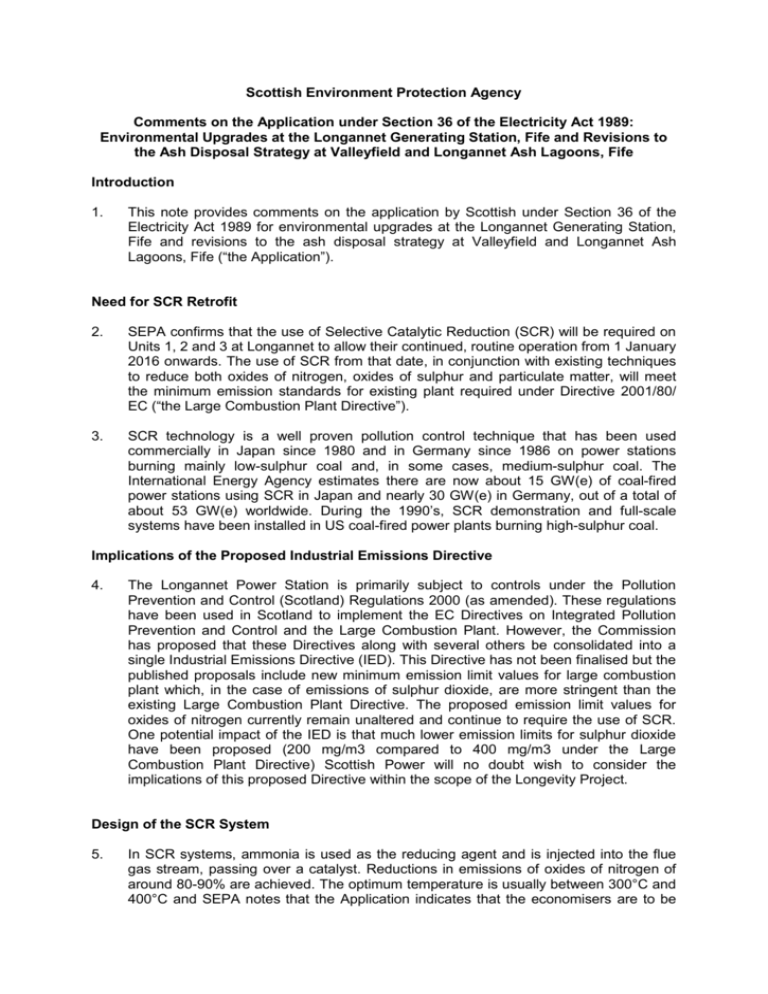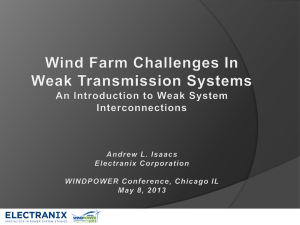Comments on SCR - The Scottish Government
advertisement

Scottish Environment Protection Agency Comments on the Application under Section 36 of the Electricity Act 1989: Environmental Upgrades at the Longannet Generating Station, Fife and Revisions to the Ash Disposal Strategy at Valleyfield and Longannet Ash Lagoons, Fife Introduction 1. This note provides comments on the application by Scottish under Section 36 of the Electricity Act 1989 for environmental upgrades at the Longannet Generating Station, Fife and revisions to the ash disposal strategy at Valleyfield and Longannet Ash Lagoons, Fife (“the Application”). Need for SCR Retrofit 2. SEPA confirms that the use of Selective Catalytic Reduction (SCR) will be required on Units 1, 2 and 3 at Longannet to allow their continued, routine operation from 1 January 2016 onwards. The use of SCR from that date, in conjunction with existing techniques to reduce both oxides of nitrogen, oxides of sulphur and particulate matter, will meet the minimum emission standards for existing plant required under Directive 2001/80/ EC (“the Large Combustion Plant Directive”). 3. SCR technology is a well proven pollution control technique that has been used commercially in Japan since 1980 and in Germany since 1986 on power stations burning mainly low-sulphur coal and, in some cases, medium-sulphur coal. The International Energy Agency estimates there are now about 15 GW(e) of coal-fired power stations using SCR in Japan and nearly 30 GW(e) in Germany, out of a total of about 53 GW(e) worldwide. During the 1990’s, SCR demonstration and full-scale systems have been installed in US coal-fired power plants burning high-sulphur coal. Implications of the Proposed Industrial Emissions Directive 4. The Longannet Power Station is primarily subject to controls under the Pollution Prevention and Control (Scotland) Regulations 2000 (as amended). These regulations have been used in Scotland to implement the EC Directives on Integrated Pollution Prevention and Control and the Large Combustion Plant. However, the Commission has proposed that these Directives along with several others be consolidated into a single Industrial Emissions Directive (IED). This Directive has not been finalised but the published proposals include new minimum emission limit values for large combustion plant which, in the case of emissions of sulphur dioxide, are more stringent than the existing Large Combustion Plant Directive. The proposed emission limit values for oxides of nitrogen currently remain unaltered and continue to require the use of SCR. One potential impact of the IED is that much lower emission limits for sulphur dioxide have been proposed (200 mg/m3 compared to 400 mg/m3 under the Large Combustion Plant Directive) Scottish Power will no doubt wish to consider the implications of this proposed Directive within the scope of the Longevity Project. Design of the SCR System 5. In SCR systems, ammonia is used as the reducing agent and is injected into the flue gas stream, passing over a catalyst. Reductions in emissions of oxides of nitrogen of around 80-90% are achieved. The optimum temperature is usually between 300°C and 400°C and SEPA notes that the Application indicates that the economisers are to be modified to ensure adequate temperatures are achieved in the SCR reactor. The SCR system will be a so called “high dust” design, the most widely used configuration, with an SCR reactor positioned before the electrostatic precipitators. This is considered to be consistent with the requirement to use the Best Available Techniques (BAT) under the PPC Regulations. 6. A “high dust” design will incur a small drop in station efficiency (estimated to be around 0.2%) with a consequential small increase in the emissions of carbon dioxide per unit of electricity generated. The Application recognises that a feature of high dust designs is that ash can accumulate on the surface of the catalyst and reduce the performance of the catalyst. SEPA notes that Scottish Power plan to fit soot blowers or acoustic horns to reduce this effect. Alternative SCR designs such as “cold side” or “tail end” SCR do not suffer dust accumulation to the same extent but do incur a larger drop in station efficiency; as much 5% with a cold side design. 7. Although SCR is a well proven pollution control technique it can introduce several complicating factors to the operation of a coal fired power station. The first is that the reaction between ammonia and oxides of nitrogen in the SCR reactor does not proceed to total completion, and a small amount of ammonia can passes through the catalyst. Some of this residual ammonia will be oxidised to nitrogen on the catalyst bed, but some may pass through the catalyst untouched. This is known as ammonia slip. As well as being an air pollutant in its own right, the presence of ammonia in the flue gases can affect ash quality which can impact on disposal or re-use of the ash. SEPA understands that a well designed, well operated system will result in less than 2 ppm of ammonia in the flue gas and that, based on experience in both the US and Europe, this is unlikely to adversely affect ash quality (Reference: Buecker, B., “SCR: Design and Operation”, 2002) or the environmental impact of the process. Scottish Power have recognised the importance of this issue within the Application and SEPA would wish to place controls within the environmental licence, known as a PPC permit, for the Longannet Power Station to ensure this limit is met. 8. SEPA notes that the EIA Scoping Report indicates that the ammonia used in the SCR reactor is to be handled in aqueous form. This together with the proposed volumes to be stored should ensure that the installation does not fall within the scope of the Control of Major Accident Hazard Regulations 1999 (as amended). SEPA will wish to ensure that the proposed methods for handling aqueous ammonia in the SCR system are consistent with the use of the Best available Techniques, particularly in terms of controlling odorous emissions. This will be done as and when Scottish Power come forward with an application to vary the environmental licence for the station to include SCR. Impact on Local Air Quality 9. SEPA agrees with the conclusions within the Application that the use of the SCR system will not adversely affect air quality. Indeed some small benefit in terms of ambient levels should be seen. SEPA has previously carried out dispersion modelling of the current emissions from Longannet (with FGD in place and current measures in place to control oxides of nitrogen) and concluded that there was unlikely to be an adverse impact on local air quality. 10. The modelling forming part of the application has used a recognised Gaussian model (AERMOD) and suitable long term data. Under the terms of both the current PPC permit for Longannet Power Station and the previous environmental licence Scottish Power has been required to carry out environmental monitoring at Blair Mains Farm (for sulphur dioxide) and annual assessment of emissions. The latter has involved modelling of emissions and these studies have meteorological data from Blair Mains and Gogar Bank. It is not clear why this meteorological data has not been used in this study as it is arguably more representative. 11. Notwithstanding the comments in the previous paragraph the well established monitoring programme for Blair has consistently showed that the Gaussian dispersion models are conservative and that measured data is consistently lower than predicted levels. 12. It is not clear from the study what value of surface roughness in the model has been used. This is a key part of air dispersion models as the predicted levels are sensitive to this parameter. Impact of Emissions on Nearby Habitats 13. SEPA agrees with the conclusions of the modelling carried out in assessing the impact of emissions into the air on nearby habitats. SEPA has previously reached similar conclusions in determining Scottish Power’s application for a PPC Permit in 2006 and 2007. That work compared the maximum ground level concentrations predicted by the dispersion modelling against the air quality limit values for the protection of vegetation and indicated that the contribution to the limit value was insignificant. The predicted location of the maximum ground level concentrations was very close to the Firth of Forth SPA and SSSI. This site is a complex of estuarine and coastal habitats stretching east from Alloa to the coasts of Fife and East Lothian. The site includes extensive invertebrate rich intertidal flats and rocky shores, areas of saltmarsh, lagoons and sand dune. The mudflats form important feeding grounds for the abundant waders and wildfowl in the Firth of Forth. 14. In addition, an impact assessment of predicted emissions from major coal and oil fired power stations on conservation sites has been carried out by the Joint Environmental Programme (JEP) 15. The results indicated: that the Lielowan Meadow is the designated site most affected by Longannet Power Station with contributions of 26.7 % of the limit value for sulphur dioxide and 5.2 % of the limit value for oxides of nitrogen. the limit value for vegetation for sulphur dioxide is not exceeded at designated sites. There are no local SSSIs where the critical level for sulphur dioxide or oxides of nitrogen is exceeded. Impact of Emissions into the Air on Nitrogen Deposition and Critical Loads 16. Critical loads are quantitative estimates of exposure to one or more pollutants that would cause harmful effects on sensitive elements in the environment. National critical loads have been mapped for a range of UK Biodiversity Action Plan Broad Habitats to assess the large scale impact of acid and nutrient nitrogen deposition across Europe. 17. The methodology used in the Application for assessing critical loads and deposition is similar to an Appropriate Assessment carried out by SEPA in 2007 as part of the determination of Scottish Power’s application for a PPC Permit. That Assessment concluded: a) The emissions from Longannet Power Station would not have an adverse effect on the integrity of any the SACs or SPA assessed in the Appropriate Assessment. b) The sites assessed in the Appropriate Assessment were selected as worstcase representative sites and emissions from the Longannet Power Station would not have an adverse effect on the integrity of any other SAC or SPA within the UK. c) The emissions from Longannet Power Station would not have an adverse effect on the integrity of the Firth of Forth SPA. d) The emissions from Longannet Power Station would not be likely to damage any natural feature of any of the SSSIs in the vicinity of Longannet. 18. The Appropriate Assessment referred to above is included at Annex A and supports the conclusions within the Application concerning the fact that SCR will be beneficial in terms of nitrogen deposition and critical loads. Continued Use of Coal 19. Following the Energy Review in 2006, the Government published “Meeting the Challenge: A White Paper on Energy”, Cm 7124 (“The Energy white Paper”), in 2007. This noted that coal had an important role to play the UK’s energy mix and that making the best use of UK energy resources, including coal reserves, where it is economically viable and environmentally acceptable to do so and contributes to the goal of secure energy supplies. Alternatives to SCR 20. Whilst fully recognising the part coal has to play in providing energy, practicalities and the significant additional costs to Scottish Power of the alternatives to fitting SCR at Longannet: i.e. retrofitting supercritical steam boilers or providing a gas fired combined cycle plant. These alternatives appear to have been dismissed very quickly. Both would result in a significant reduction in the amount of carbon dioxide emitted per unit of electricity generated. 21. The Longannet Power station after the fitment of SCR would be around 35% efficient. Supercritical boilers would result in a generation efficiency of around 45% and a gas fired combined cycle plant could achieve around 58% efficiency. The latter would potentially cut specific emissions of carbon dioxide by around half. Heat Plan 22. The consideration of using waste energy from Longannet for beneficial use (heat plan) does not appear to be fully developed. The difficulty in developing a heat distribution system and using surplus heat is fully recognised. However, options to use waste heat could be better developed. SEPA, in its Thermal Treatment of Waste Guidelines 2009 requires applicants for PPC permits to submit a “Heat Plan” – a systematic assessment of where low grade heat could be used. SEPA would be pleased to submit an exemplar of such a Heat Plan. The requirement for the development of a Heat Plan could be a condition of any Section 36 consent granted by the Scottish government. Controls over Noise During Construction 23. The proposed limitations over noise during construction of the SCR system should help limit noise nuisance from the construction area and are welcomed. R Ebbins 15 June 2009 Annex A: Appropriate Assessment Made During Determination of the PPC Permit for Longannet









